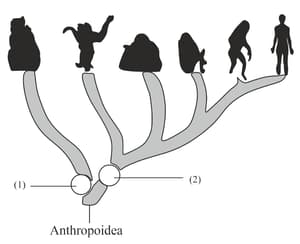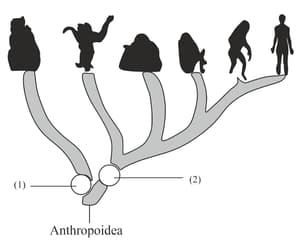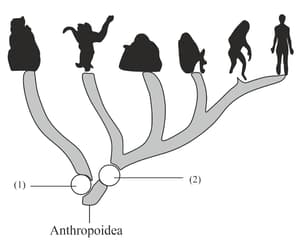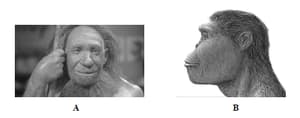What are the features of Homo habilis?
Important Questions on Evolution
An illustration related to human evolution is given. Analyse it and answer the following questions:

Write the names of categories (i) and (ii).
Identify the word pair relation and fill the blanks,
Monkeys : Cercopithecoidea : : Chimpanzee : _____
An illustration related to human evolution is given. Analyse it and answer the following questions:

Mention the two important characteristics of organisms belong to (2).
Prepare a flow chart showing the evolution of modern man in the hierarchical order of their evolution using the details given below:
Homo erectus, Homo habilis, Dryopithecus, Australopithecines, Homo sapiens, Ramapithecus, Neanderthal man
An illustration related to human evolution is given. Analyse it and answer the following questions:

How does the comparative study of haemoglobin helped to identify the evolutionary relationship between man and chimpanzee ?
Write the names of the following:
A 2 mya primate that lived in East African grasslands.
Given below are sets of five terms each. Rewrite the terms in correct order in a logical sequence beginning with the first word that is underlined:
Australopithecus, Cro-Magnon Man, Homo erectus, Neanderthal Man, Homo sapiens.
Write the names of the following :
A 15 mya primate that was ape-like.
Given below are two stages in the evolution of man.
Study them and answer the questions that follow:

(i) Identify Australopithecus and Neanderthal man from the above pictures.
(ii) Mention two characteristic features each for the two stages.
(iii) Who proposed the theory of ‘Natural Selection'?
(iv) Name the organism used as an example to explain ‘Industrial Melanism’.
(v) Give two examples of Vestigial organs in humans.
| Column – I | Column – II | ||
|---|---|---|---|
| Homo habilis | 900 cc | ||
| Homo neanderthalensis | 1350 cc | ||
| Homo erectus | 650-800 cc | ||
| Homo sapiens | 1400 cc |
Select the correct option.

